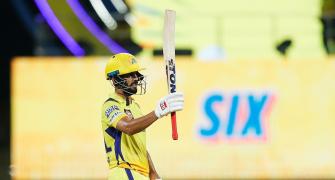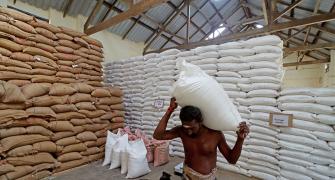.jpg?w=670&h=900) "The forex reserves had depleted to a point where India could hardly finance imports of even three weeks."
"The forex reserves had depleted to a point where India could hardly finance imports of even three weeks."
This anonymous line puts the balance of payments (BoP) crisis of 1990-91 in context.
Then, the trade deficit was hardly 2.9 per cent of the gross domestic product.
In 2011-12, it was 10.2 per cent of the GDP and rose to 10.37 per cent in 2012-13.
Two years of trade deficit touching 10 per cent and with signs of it breaching the 10-per cent mark again in the current financial year give the impression India might be on the verge of another BoP crisis.
The trade deficit makes up an important part of the current account deficit, which had touched an all-time high of 4.8 per cent in 2012-13.
In spite of that, it need not be assumed that India has reached the stage of the BoP crisis of 1990-91.
The forex reserves of $284 billion could easily finance 59 per cent of India’s imports, valued at $491 billion in 2012-13.
Despite the increase in CAD, India added $3.8 billion to the forex kitty in 2012-13, though a small accretion.
“Today we have the wherewithal to finance at least seven to eight months’ imports,” said Ajit Ranade, chief economist, AV Birla Group.
He cited a paper by the commerce and industry ministry that said the government assumed the trade deficit would be $300 billion by 2013-14. So, though the trade deficit looks large, it was expected.
On the import front, it was mainly oil and gold imports exerting pressure.
The large-scale import of fertilisers, coal, edible oil, steel, and iron ore also pushed up inbound shipments, though these rose just 0.3 per cent in 2012-13.
During 1990-91, exports were $18.1 billion, while imports were $24.07 billion, resulting in a trade deficit of $5.93 billion.
In 2012-13, exports reached $300.6 billion, while imports were $491.5 billion, leaving a deficit of $191
The deficit was $183.4 billion in 2011-12.
During the BoP crisis, the rupee was hugely overvalued. The government devalued it 18-19 per cent.
Now the authorities are trying to arrest the fall, though many feel the rupee is still overvalued.
In 1991-92, exports had declined 1.5 per cent, but rose 3.8 per cent a year later.
Rupee devaluation, coupled with export promotion policies, led to a rise in exports by 20 per cent in 1993-94, followed by 18.4 per cent the next year and 20.8 per cent in 1995-96.
When the BoP crisis hit, the government changed the trade policy from its highly-restrictive form to freely-tradable Exim scrips, which allowed exporters to import 30 per cent of the value of their exports.
Those days, India used to export items such as gems & jewellery, engineering goods, textiles and certain agricultural products. But now it includes a lot: High-value engineering goods, refinery oil products, pharmaceutical drugs, etc.
Though the rupee depreciated 14 per cent year-on-year in 2012-13, no exporter is smiling his way to the bank.
Exports dipped 1.8 per cent in 2012-13.
The exports managed to grow 1.7 per cent at $24.16 billion in April, but again dipped 1.1 per cent in May at $24.5 billion.
“Exporters hedge their contracts.
"So, those who hedged the rupee at 55 or 57 are facing losses.
"Also, the global demand is modest.
"But there is no likelihood of a default,” said Abheek Barua, chief economist, HDFC Bank.
CRISIL said the global economic environment and re-negotiations of contracts by clients would limit the leverage of export companies.
It said despite a falling rupee, 180 listed export companies, which make up 12 per cent of exports, reported a one-two per cent growth in revenues in dollar terms and 60-basis-point rise in earnings before interest, taxes, depreciation and amortisation margins in 2012-2013.








